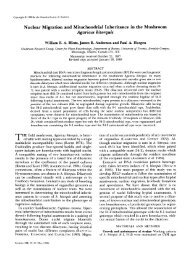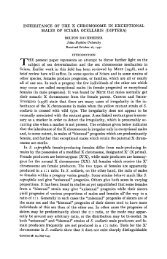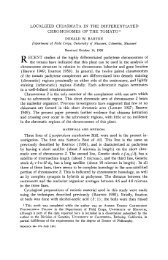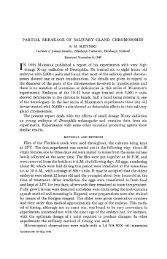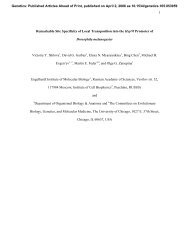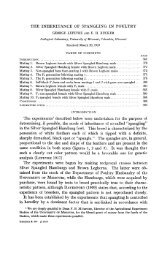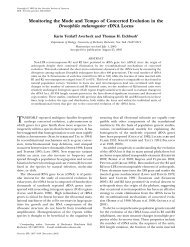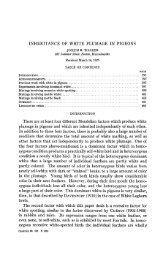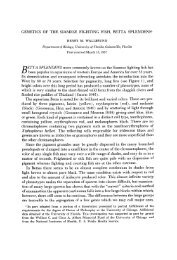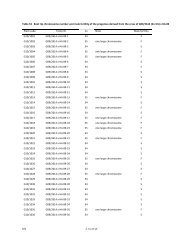abstracts of papers presented at the 1962 meetings - Genetics
abstracts of papers presented at the 1962 meetings - Genetics
abstracts of papers presented at the 1962 meetings - Genetics
Create successful ePaper yourself
Turn your PDF publications into a flip-book with our unique Google optimized e-Paper software.
ABSTRACTS 991<br />
XI1I.-These observ<strong>at</strong>ions can be explained by a hypo<strong>the</strong>sis which assumes th<strong>at</strong>: (1) <strong>the</strong> mt and<br />
N loci control separ<strong>at</strong>e steps in a sequence which results in <strong>the</strong> production <strong>of</strong> <strong>the</strong> XIV m<strong>at</strong>ing<br />
type substance; (2) <strong>the</strong> ability <strong>of</strong> <strong>the</strong> macronucleus to differenti<strong>at</strong>e to control only one <strong>of</strong> two<br />
altern<strong>at</strong>ive m<strong>at</strong>ing type potentialities reflects <strong>the</strong> ability <strong>of</strong> <strong>the</strong> wild-type allele <strong>at</strong> <strong>the</strong> mt locus<br />
(or, less likely, <strong>at</strong> <strong>the</strong> N locus) to be repressed when differenti<strong>at</strong>ion occurs in <strong>the</strong> presence <strong>of</strong> a<br />
hypo<strong>the</strong>tical substance, “R’; (3) “R” is a precursor <strong>of</strong> <strong>the</strong> XIV m<strong>at</strong>ing type substance. (Sup-<br />
ported by a grant from <strong>the</strong> N<strong>at</strong>isonal Science Found<strong>at</strong>ion.)<br />
THOMPSON, PETER E., Iowa St<strong>at</strong>e University, Ames, Iowa: Synaptic modific<strong>at</strong>ion <strong>of</strong> dominant<br />
lethal frequencies after irradi<strong>at</strong>ion <strong>of</strong> <strong>the</strong> Drosophila testis.-Increases in <strong>the</strong> mutability <strong>of</strong> unpaired<br />
chromosomes have led to <strong>the</strong> interpret<strong>at</strong>ion (THOMPSON, <strong>Genetics</strong> 47:337, <strong>1962</strong>) th<strong>at</strong> <strong>the</strong><br />
synapsis <strong>of</strong> homologous chromosomes is a major factor in <strong>the</strong> repair <strong>of</strong> radi<strong>at</strong>ion induced chromosomal<br />
damage. This hypo<strong>the</strong>sis is subtanti<strong>at</strong>ed by <strong>the</strong> present d<strong>at</strong>a on <strong>the</strong> production <strong>of</strong> dominant<br />
lethals among males in which complex structural heterozygosity (presence <strong>of</strong> multiple inversion<br />
SM5) has cre<strong>at</strong>ed almost total asynapsis <strong>of</strong> one major pair <strong>of</strong> chromosomes. Egg development<br />
among one-day broods from such males after X-ray tre<strong>at</strong>ment gave evidence <strong>of</strong> an appreciable<br />
increase in dominant lethals <strong>of</strong> meiotic origin, in comparison with males lacking structural heterozygosity.-The<br />
brood p<strong>at</strong>tern <strong>of</strong> dominant lethals from irradi<strong>at</strong>ed control males shows a<br />
pl<strong>at</strong>eau <strong>of</strong> maximum frequency from early meiosis to sperm<strong>at</strong>id stages, i.e., among sperm sampled<br />
from <strong>the</strong> fifth to <strong>the</strong> eighth day after irradi<strong>at</strong>ion. Broods from irradi<strong>at</strong>ed SM5 males gave<br />
similar frequencies for premeiotic and postmeiotic stages, including <strong>the</strong> fifth and tenth brood<br />
periods, but during days 6-8 about twice as many dominant lethals were scored among <strong>the</strong>se<br />
lines. If dominant lethals may be equ<strong>at</strong>ed with highly aberrant rearrangement or loss <strong>of</strong> chromosome<br />
fragments, asynapsis appears to contribute markedly to gross genetic damage during<br />
meiosis. (Supported by Grant RG-8912 from <strong>the</strong> N<strong>at</strong>ional Institutes <strong>of</strong> Health.)<br />
TUVESON, R. W., Department <strong>of</strong> Botany, University <strong>of</strong> Chicago, Chicago 37, Illinois: Hyphal<br />
tip isol<strong>at</strong>ion as a criterion for heterocaryosis.-Specific heterocaryons between auxotrophic strains<br />
<strong>of</strong> Cephalosporium mycophilum exhibit selection for <strong>the</strong> incorpor<strong>at</strong>ion <strong>of</strong> one <strong>of</strong> <strong>the</strong> nuclear<br />
types into <strong>the</strong> conidia produced by <strong>the</strong> heterocaryon. Growing <strong>the</strong> specific heterocaryons on<br />
supplemented minimal medium resulted in altered nuclear proportions and recovery <strong>of</strong> <strong>the</strong><br />
minor nuclear component. Hyphal tip isol<strong>at</strong>ions from one <strong>of</strong> <strong>the</strong> heterocaryons exhibiting selection<br />
when grown on minimal medium were incapable <strong>of</strong> continued growth on minimal medium<br />
although tips transferred to complex medium grew vigorously. These results suggested th<strong>at</strong> <strong>the</strong><br />
hyphal tips were homocaryotic for <strong>the</strong> dominant nuclear component. However, <strong>the</strong> heterocaryotic<br />
n<strong>at</strong>ure <strong>of</strong> <strong>the</strong> mycelium had been previously established by <strong>the</strong> isol<strong>at</strong>ion <strong>of</strong> a som<strong>at</strong>ic diploid<br />
from which recombinants were subsequently recovered. Manipul<strong>at</strong>ing concentr<strong>at</strong>ions <strong>of</strong> supplements<br />
in <strong>the</strong> minimal medium on which <strong>the</strong> heterocaryon was grown has resulted in <strong>the</strong> isol<strong>at</strong>ion<br />
<strong>of</strong> hyphal tips able bo grow on minimal medium. Supplement<strong>at</strong>ion <strong>of</strong> <strong>the</strong> medium presumably<br />
altered nuclear proportions, thus allowing for <strong>the</strong> isol<strong>at</strong>ion <strong>of</strong> hyphal tips capable <strong>of</strong> growth on<br />
minimal medium. In species <strong>of</strong> Fusarium, isol<strong>at</strong>ion <strong>of</strong> hyphal tips from specific hetercaryons<br />
exhibiting selective incorpor<strong>at</strong>ion <strong>of</strong> nuclear types into conidia revealed th<strong>at</strong> a high proportion<br />
<strong>of</strong> <strong>the</strong>se tips were capable <strong>of</strong> continued growth on minimal medium. These results suggest th<strong>at</strong><br />
selection was not severe enough in <strong>the</strong>se heterocaryons to preclude <strong>the</strong> isol<strong>at</strong>ion <strong>of</strong> heterocaryotic<br />
hyphal tips. These experiments indic<strong>at</strong>e th<strong>at</strong> <strong>the</strong> inability to isol<strong>at</strong>e hyphal tips capable <strong>of</strong> continued<br />
growth on minimal is not conclusive evidence against heterocaryosis, but may reflect<br />
severe selection resulting in a high proportion <strong>of</strong> homocaryotic tips. The results with Fusarium<br />
indic<strong>at</strong>e th<strong>at</strong> selective incorpor<strong>at</strong>ion <strong>of</strong> nuclei into conidia need not result in homocaryotic tips.<br />
UNDERKOFLER, JUDITH, and M. R. IRWIN, University <strong>of</strong> Wisconsin, Madison, Wisconsin:<br />
Inieraction products <strong>of</strong> new combin<strong>at</strong>ions <strong>of</strong> genes in species crosses <strong>of</strong> Co1umbidae.-A hybrid<br />
substance is defined as an antigenic product <strong>of</strong> <strong>the</strong> erythrocytes <strong>of</strong> an individual (species hybrid





